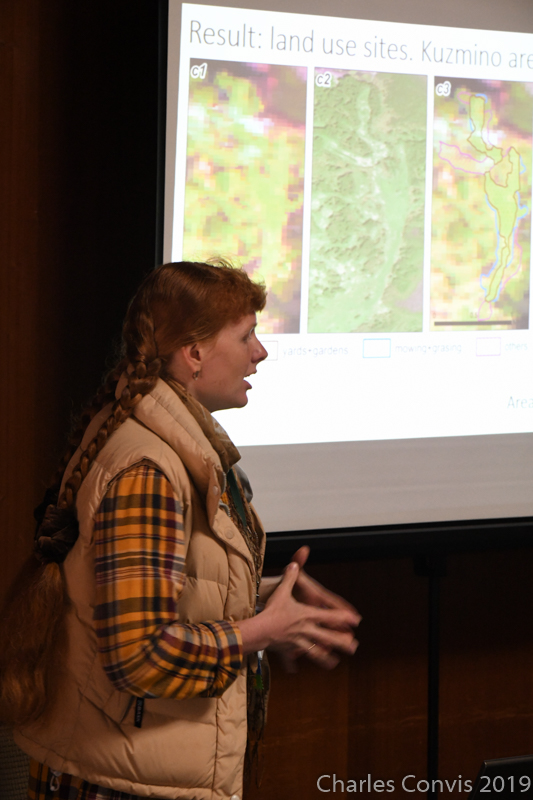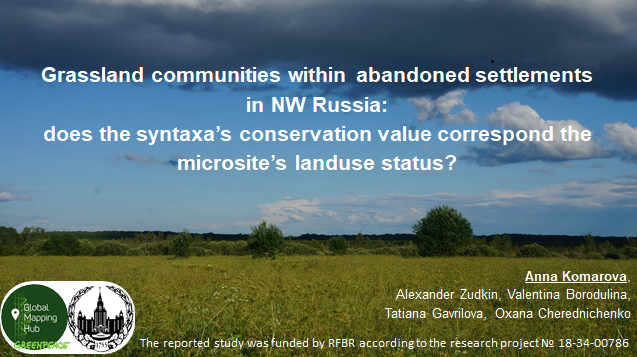- Home
- :
- All Communities
- :
- User Groups
- :
- Conservation GIS
- :
- Documents
- :
- Anna Komarova 2019 Conference Talk
- Subscribe to RSS Feed
- Mark as New
- Mark as Read
- Bookmark
- Subscribe
- Printer Friendly Page
Anna Komarova 2019 Conference Talk
Anna Komarova 2019 Conference Talk
Anna Komarova, Greenpeace, Russia x2019Talk xVegetation xClimate Change xGrassland xSuccession xRussia

Paper Presentation -pdf
Video -mp4
ABSTRACT: "Grassland Communities Within Abandoned Settlements in Northwest Russia: Does the Syntaxa’s Conservation Value Correspond the Microsite’s Land Use Status? " Anna Komarova
Herbaceous communities are widespread in the European part of Russia and connected with human activity. The restorative succession of abandoned croplands and settlements was investigated before, but the syntaxonomy (and communities’ relative conservation value) and the drivers of their spatial structure remained beyond the scope of previous studies. Our research aimed to test the hypothesis that the syntaxa, as repercussion of ecology conditions and conservation value, correspond to land use history. To classify the vegetation according to Braun-Blanquet’s approach, ninety-eight relevés collected in 2014 and 2018 were used. Based on relevés and previous data, the conservation value of alliances was classified. A preliminary classification scheme of herbaceous vegetation was suggested for the studied area. We identified four classes: Molinio-Arrhenatheretea, PhragmitoMagnocaricetea, Epilobietea angustifolii, Artemisietea vulgaris and seven alliances: Magno-Caricion elatae, Convolvulo arvensis-Agropyrion repentis, Epilobion angustifolii, Filipendulion ulmariae, Calthion palustris, Molinion caeruleae, Arrhenatherion elatioris. The ecological portraits of the syntaxa and conservation value criteria are provided. It was partially based on remote sensing data using the preliminary outlines of special spectral reflectance in some ecological positions (humidity, edge, nitrified sites). The conservation value was based on criteria of i) species richness ii) plant life forms and ecological diversity and iii) the amount of rare species. The structure of microsites and the type of management (mowing and grazing, gardens and yards, and other areas) were reconstructed based of Landsat 5 image (19 May 1985, ESA archive). We also have tested the hypotheses that grass fires negatively affect the conservation value of the area using the year-by-year grass fire history since 2000 (65 scenes of Landsat and Sentinel were analyzed) and the Spearmen correlation analysis. The chi-square correspondence analysis showed the uncontingency for sites and alliances on p-level = 7,17*10-6 and for sites and classes on p-level = 4,26*10-7. Spearmen correlation between the abundance of Calamagrostis epigeios (associated with the lowers conservation value communities) and the frequency of fires was 0,5 (p<0,01). Thus, the localization of syntaxa corresponded to the land use history. After about 30 years of abandonment on the place of houses, yards and gardens, the plant communities of alliances Convolvulo arvensis-Agropyrion repentis (class Artemisietea vulgaris) and Epilobion angustifolii (class Epilobietea angustifolii) have formed. Within mowed and grazed sites, the communities of Molinio-Arrhenatheretea (dominated by Molinion caeruleae and Calthion palustris alliances for formerly mowed and grazed areas surrounding the village) have appeared. The most conservation valued communities, Molinion caeruleae was formed on the mowed and grazing sites without burning. The lowest conservation-value communities were dominated by Calamagrostis epigeios. Thus, during thirty years of abandoning, the conservation value was partially restored – except the regularly-burned areas, where the invasion of Calamagrostis epigeios lead to the forming of sustainable low conservation-value communities. The reported study was funded by Russian Foundation for Basic Research (RFBR) according to the research project No. 18-34-00786.


